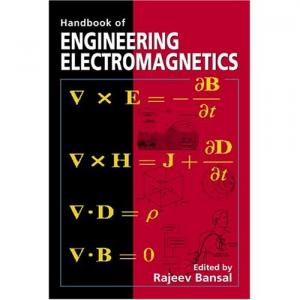
Preface
This handbook is intended as a desk reference for the broad area of engineering
electromagnetics. Since electromagnetics provides the underpinnings for many technological
fields such as wireless communications, fiber optics, microwave engineering,radar, electromagnetic compatibility, material science, and biomedicine, there is a great deal of interest in and need for training in the engineering applications of electromagnetics.Practicing engineers in these diverse fields need to understand how engineering electromagnetic principles can be applied to the formulation and solution of actual engineering problems. As technologies wax and wane and engineers move around, they find themselves learning new applications on the run.
The Handbook of Engineering Electromagnetics should serve as a bridge between
standard textbooks in electromagnetic theory and specialized references such as a
handbook on wireless antenna design. While textbooks are comprehensive in terms of the
theoretical development of the subject matter, they are usually deficient in the practical
application of that theory. Specialized handbooks, on the other hand, often provide
detailed lists of formulas, tables, and graphs, but do not provide the insight needed to
appreciate the underlying physical concepts. This handbook will permit a practicing
engineer/scientist to
Review the necessary electromagnetic theory in the context of the application
Gain an appreciation for the key electromagnetic terms and parameters
Learn how to apply the theory to formulate engineering problems
Obtain guidance to the specialized literature for additional details.
Since the Handbook of Engineering Electromagnetics is intended to be useful to
engineers engaged in electromagnetic applications in a variety of professional settings, the
coverage of topics is correspondingly broad in scope (as can be inferred from the table
of contents). In terms of fundamental concepts, the book includes coverage of Maxwell
equations, static fields, electromagnetic induction, waves, transmission lines, waveguides,
technologies, radar, wireless communication, satellite communication, and optical
communication are covered provides an introduction to various numerical techniques being used for computer-aided solutions to complex electromagnetic problems. Given the ubiquitous nature of electromagnetic fields,antennas, and electromagnetic compatibility (Chapters 1–10). In terms of electromagnetic (Chapters 11–14). Chapter 15 provides an introductionto various numerical techniques being used for computer-aided solutions to complex electromagnetic problems. Given the ubiquitous nature of electromagnetic fields,it is important to consider their biological effects and safety standards (Chapter 16).Chapter 17 presents a concise survey of current and evolving biomedical applications,
while Chapter 18 is a review of the techniques used for measuring the electromagnetic properties of biological materials. In terms of frequency range, this book spans the spectrum from static fields to light waves, with special emphasis on the radio frequency/microwave range. Pertinent data in the form of tables and graphs are provided within the context of the subject matter. In addition, Appendixes A and B are brief compilations of important electromagnetic constants and units, respectively. Finally, Appendix C is a convenient tutorial on vector analysis and coordinate systems.
Rajeev Bansal
Product Details
Hardcover: 720 pages
Publisher: CRC; 1 edition (September 1, 2004)
Language: English
ISBN-10: 0824756282
ISBN-13: 978-0824756284
Review:
This book bridges the gap between traditional e-mag books and the specialized handbooksgives a review of electromagnetic theory in the context of applications, provides key terms and equations, teaches how to apply the theory to real engineering problems, and provides references to other works definitely a worthwhile addition to your library.
-IEEE Electrical Insulation Magazine, Vol. 22, No. 5, September-October 2006
[Chapters are] accompanied with practical engineering applications and useful illustrations, as well as a good selection of references. This book will provide a useful resource for many engineers working in applied electromagnetics .
- The IEE Online, 2004
This handbook fills the niche of covering many industrial electromagnetic applications. University professors would also find this book useful for adding practical applications to field theory lectures and homework. This book provides an excellent tour of the practical side of electromagnetics.
- IEEE Microwave Magazine, March 2005
The bio-electromagnetics chapters are particularly well equipped with references, having more than 100 each and collectively accounting for around 40% of more than 900 references cited in the handbook.
Those chapters that are devoted to areas that I am less familiar with, but currently have a need to address, have certainly been valuable to me. This book will therefore provide a useful resource for many engineers working in applied electromagnetics, particularly those in the early stages of their careers.
-Alastair R. Ruddle, Consultant Engineer at Mira Ltd., Warwickshire, UK
Succinct application-oriented treatment, presenting formulas, tables, and graphs.
IEEE Microwave Magazine, September 2005
[
本帖最后由 lilik 于 2008-4-10 06:52 PM 编辑 ]
